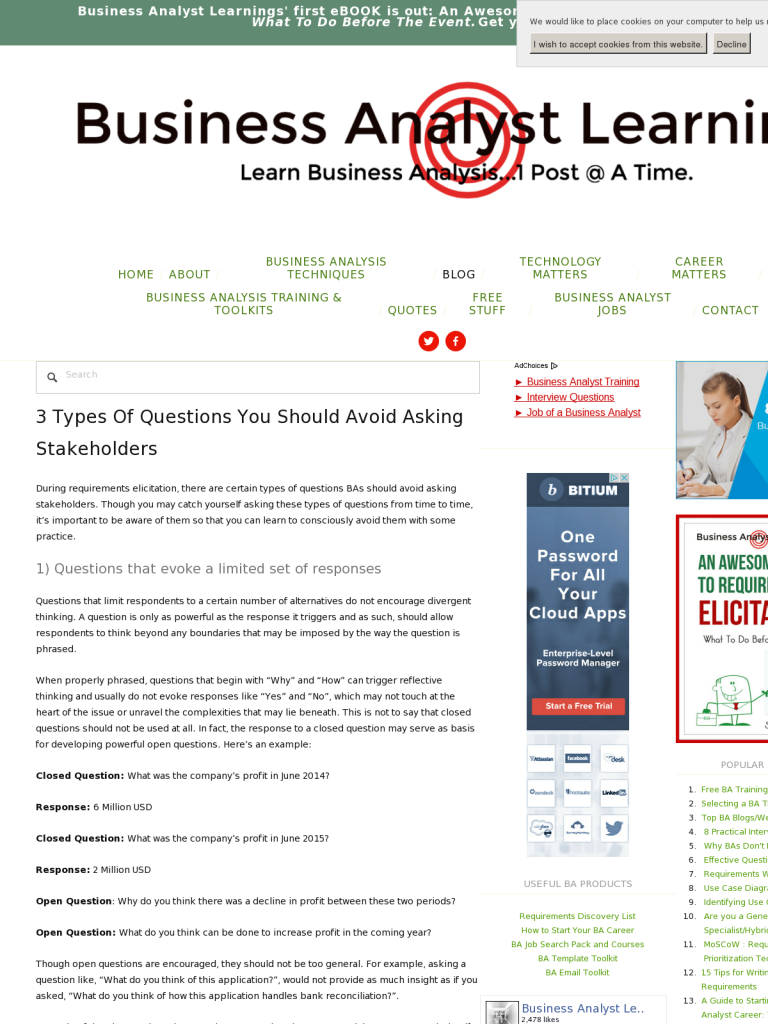3 Types Of Questions You Should Avoid Asking Stakeholders
Blog: Business Analyst Learnings Blog
During requirements elicitation, there are certain types of questions BAs should avoid asking stakeholders. Though you may catch yourself asking these types of questions from time to time, it’s important to be aware of them so that you can learn to consciously avoid them with some practice.
1) Questions that evoke a limited set of responses
Questions that limit respondents to a certain number of alternatives do not encourage divergent thinking. A question is only as powerful as the response it triggers and as such, should allow respondents to think beyond any boundaries that may be imposed by the way the question is phrased.
When properly phrased, questions that begin with “Why” and “How” can trigger reflective thinking and usually do not evoke responses like “Yes” and “No”, which may not touch at the heart of the issue or unravel the complexities that may lie beneath. This is not to say that closed questions should not be used at all. In fact, the response to a closed question may serve as basis for developing powerful open questions. Here’s an example:
Closed Question: What was the company’s profit in June 2014?
Response: 6 Million USD
Closed Question: What was the company’s profit in June 2015?
Response: 2 Million USD
Open Question: Why do you think there was a decline in profit between these two periods?
Open Question: What do you think can be done to increase profit in the coming year?
Though open questions are encouraged, they should not be too general. For example, asking a question like, “What do you think of this application?”, would not provide as much insight as if you asked, “What do you think of how this application handles bank reconciliation?”.
As a rule of thumb, questions that contain terms such as interpret, explain, compare, and what if, to mention a few, are indicative of questions that trigger deep thinking and evoke insightful responses.
2) Loaded Questions
These are questions that are extremely difficult to answer because they contain presumptions that are either flawed or presumptions the respondent does not agree with. With loaded questions, more than one question is being asked. E.g. Are you still selling to cash customers on credit?
Answering “No” to this question would imply that the respondent once sold items on credit to cash customers while answering “Yes” would be a direct admission of policy violation.
A loaded question could mean one that is loaded with false presumptions or one that is difficult to answer because it involves addressing more than one question at the same time.
3) Run-on Questions
Ask only one question at a time so that you can get one response at a time. Run-on Questions often mean that the respondent will have to answer one before the next, thereby increasing the probability of the respondent forgetting one of the questions or not answering one completely before moving to the next.
Here’s an example of a Run-on Question: “Which regions have the highest number of complaints, what do most people complain about and why do you think this is so?”
What other types of questions should be avoided?
Picture Attribution: “Beware Sign Displays Warning Alert Or Danger” by Stuart Miles/Freedigitalphotos.net
Leave a Comment
You must be logged in to post a comment.








